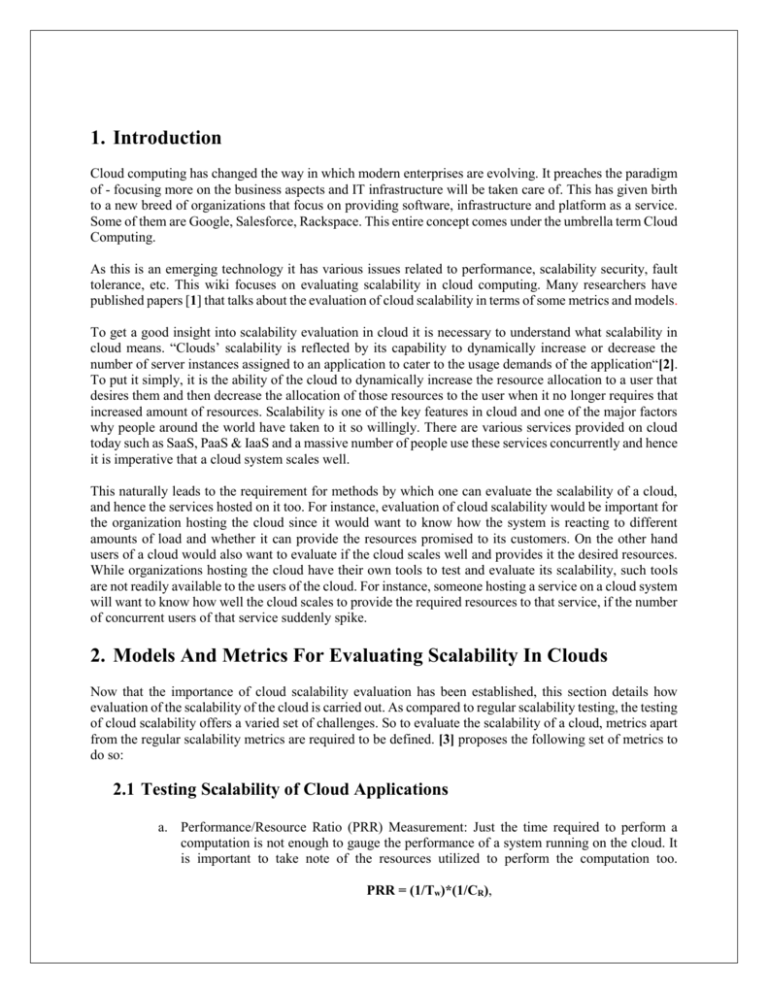ForWiki
advertisement

1. Introduction Cloud computing has changed the way in which modern enterprises are evolving. It preaches the paradigm of - focusing more on the business aspects and IT infrastructure will be taken care of. This has given birth to a new breed of organizations that focus on providing software, infrastructure and platform as a service. Some of them are Google, Salesforce, Rackspace. This entire concept comes under the umbrella term Cloud Computing. As this is an emerging technology it has various issues related to performance, scalability security, fault tolerance, etc. This wiki focuses on evaluating scalability in cloud computing. Many researchers have published papers [1] that talks about the evaluation of cloud scalability in terms of some metrics and models. To get a good insight into scalability evaluation in cloud it is necessary to understand what scalability in cloud means. “Clouds’ scalability is reflected by its capability to dynamically increase or decrease the number of server instances assigned to an application to cater to the usage demands of the application“[2]. To put it simply, it is the ability of the cloud to dynamically increase the resource allocation to a user that desires them and then decrease the allocation of those resources to the user when it no longer requires that increased amount of resources. Scalability is one of the key features in cloud and one of the major factors why people around the world have taken to it so willingly. There are various services provided on cloud today such as SaaS, PaaS & IaaS and a massive number of people use these services concurrently and hence it is imperative that a cloud system scales well. This naturally leads to the requirement for methods by which one can evaluate the scalability of a cloud, and hence the services hosted on it too. For instance, evaluation of cloud scalability would be important for the organization hosting the cloud since it would want to know how the system is reacting to different amounts of load and whether it can provide the resources promised to its customers. On the other hand users of a cloud would also want to evaluate if the cloud scales well and provides it the desired resources. While organizations hosting the cloud have their own tools to test and evaluate its scalability, such tools are not readily available to the users of the cloud. For instance, someone hosting a service on a cloud system will want to know how well the cloud scales to provide the required resources to that service, if the number of concurrent users of that service suddenly spike. 2. Models And Metrics For Evaluating Scalability In Clouds Now that the importance of cloud scalability evaluation has been established, this section details how evaluation of the scalability of the cloud is carried out. As compared to regular scalability testing, the testing of cloud scalability offers a varied set of challenges. So to evaluate the scalability of a cloud, metrics apart from the regular scalability metrics are required to be defined. [3] proposes the following set of metrics to do so: 2.1 Testing Scalability of Cloud Applications a. Performance/Resource Ratio (PRR) Measurement: Just the time required to perform a computation is not enough to gauge the performance of a system running on the cloud. It is important to take note of the resources utilized to perform the computation too. PRR = (1/Tw)*(1/CR), CR = ∑ Ri * Ti, where Ri is the allocation of resource i and Ti is the time for which the resource is used. Tw is the waiting time and Tw = Tq + Te where Tq is queuing time and Te the execution time. b. The scalability of the system can be measured using Performance Change (PC) for varying workloads PC = (PRR (t)* W (t))/ (PRR (t’)*W (t’)) Where W(t) represents the workload at time t. In an ideally scenario the value of PC should be 1. But the PC might vary between different test runs due to the complexity of the cloud system. So not only PC but also another metric called Performance Variance (PV) needs to be measured. The PV effectively measures the scalability, given the PC. PV = E [(PCi - (1/n) * ∑ni=1 PCi) 2] In an ideal scenario PC should be unity and PV should be as close to 0 as possible. 2.1.1 Methodology: Intelligent Scalability Testing Data Mining techniques can be applied to help the scalability testing process. The following methods can be used. a. Feature Selection to mine the bottleneck in scalability testing this method suggests that only the important features that affect scalability be mined to reduce the complexity of testing scalability. b. Association Rule to decide correlation between parameters and scalability This method suggests to gauge the relationship of different parameters with scalability using the association rule. c. Mining input-output relationship to reduce test cases Understanding the relationship between the input and output helps reduce the number of test cases. 2.1.2 Platform Support: Partitioning For Scalability Testing A two-layer model for partitioning as suggested in [4] partitions horizontally by tenants and vertically by columns. This model can help in both read and update operations. SaaS (Software as a Service) is a software distribution model in which software is published on a cloud by a service provider and it then can be used by users. The data required by the software too is hosted by the cloud. From the above description it can be deduced that performance and scalability of a SaaS is correlated to that of a cloud system. Hence evaluating the scalability of a SaaS will provide a fair idea regarding the scalability of the cloud system since the SaaS is hosted on the cloud. The following material is based on the SaaS implementation in clouds and thus the described metrics and models are specific to it. Many researchers have provided metrics and models to evaluate scalability in the past. But none of them were purely concentrated on cloud scalability. Rather they were centric to parallel and distributed systems. In order to define these metrics and models for cloud, application researchers [1] have used an analytical graphical model known as the radar chart/spider chart/ web chart. This chart represents the quantitative variables involved on the axes starting from the same point thereby representing the multivariate data in the form of a two dimensional chart. 2.2 System Resources Allocation and Utilization In order to evaluate the system allocated resources and their utilisation in the cloud, the following terms were described in [1]. CRAM(S,t) - Computing Resource Allocation Meter CRAM is used as an indicator to represent the total amount of resource allocation for a SaaS(S) at an evaluating time t. Now radar charts are used as a base to represent this entity graphically. Further, the axes in the radar chart represent an allocated computing resource that belongs to S in cloud. In order to calculate the total number of allocated resource to S we need to calculate the area of the radar chart. In order to compute the area we just need to calculate the area of the subsequent triangles. The formula can be listed as: CRAM(S,t) = 0.5 * sin(27l' / n) * L ai * ai + 1 where a1, a2… an represents the different types of allocated resource to S at time t Figure 1. Computing Resource Allocation Meter [1] CRUM(S,t) - Uniform Resource Allocation Meter Now, what would interest the clients and vendors is the knowledge of actual consumption of resources by the system while providing services. Thus, CRUM is used as a virtualization tool to represent and measure the cloud resource and its utilization. CRUM is also represented using the radar chart but in this case the axes represent the utilization value of an allocated resource of a deployed SaaS application at time t. A similar formula is given for CRUM. CRUM(S,t) = 0.5 * sin(27Z' / n) * LU . U + 1 i i where U U ,..., U represent the utilization of a resource allocated to application S. They are generally helpful for clients and engineers to evaluate and monitor the system performance. 1, 2 i Figure 2. Computing Resource Utilization Meter [1] 2.3 System Scalability Measurement Wikipedia states that “The key characteristic of scalable system is that with increased load the application can perform at the same throughput level by addition of more resources and avoiding major system modifications”. Thus using this concept researcher [1] proposed the concept of determining scalability via their proposed metrics and models for system load, system utilization and system performance. Their system is based on the system’s effective capacity at time t. Thus they define the Effective System Scalability (ESS) as the ratio of system load increase and system capacity increase. ESS = [SL(t) -SL(min)]/[SEC(t) - SEC(min)] ... [1] where SL(t) stands for system load at time t and SL(min) is the minimum system load and similarly the SEC(t) stands for system effective capacity at time t and SEC(min) refers to the minimum capacity of the system. Further, the authors defined the ESR (Effective Scalable Range) as the difference of SEC(max) and SEC(min). ESR = SEC(max) - SEC(min) … [1] 3. Case Study of Amazon EC2 for the Scalability Evaluation In the earlier section of the wiki we saw that researchers [1] have provided metrics and models to evaluate the scalability of cloud. In order to verify the correctness and effectiveness of these metrics and models they also performed a test on the Amazon EC2 cloud technology. They performed the test on all five instances of the Amazon EC2 i.e. Micro, Small, Large, and Extra-Large Main purpose of this case study was: 1. To learn what scalability parameters and performance indicators are actually collectable and traceable in cloud applications. 2. To check whether the proposed models and metrics fit in the real world scenario. Following technologies and configurations were used to perform the case study: In this case study, a java based application program to calculate Fast Fourier Transform is deployed on each instance of EC2 and each EC2 instance is configured and monitored to analyse the performance and evaluate scalability of the cloud environment. APIs provided by Amazon like CloudWatch, Autoscaling and Elastic Load Balancing are used to configure the instance of EC2 and gather required metrics. Amazon CloudWatch API allows its users to obtain information about resource utilization, application performance, and operational health. For Amazon EC2 instances, Amazon CloudWatch collects metrics for CPU utilization, disk usage activity and data transfer from each Amazon EC2 instance. [5] Auto Scaling APIs are used to scale capacity of Amazon EC2 instance up or down automatically according to defined conditions. With the help of this, user can ensure that the number of Amazon EC2 instances will increase when the demand increases to maintain performance of the system and decreases automatically if demand drops to minimum cost. When average CPU utilization goes above upper bound of threshold value, auto group scaling APIs can be used to set condition to add new Amazon EC2 instances in increments of 3 instances to the group and similarly, condition to remove Amazon EC2 instances in the same increments can be set when CPU Utilization falls below upper bound of threshold value.[6] Elastic load balancing service provided by amazon distributes incoming traffic across multiple instances of Amazon EC2. Elastic load balancing APIs are used to apply different loads on EC2 instances collect the values of parameters required for evaluating. [7] Following steps are followed to set up [1] : Amazon EC2 instance management API is used to set up and configure the EC2 application instance CloudWatch API is used to configure and monitor resource utilization metrics and performance parameters. Autoscaling API is used to configure and monitor EC2 instance for computing resource utilization and performance data. Following figure shows set up done for the case study of scalability evaluation and performance analysis of cloud environment [1]: Figure 3. The EC2 cloud infrastructure and procedure steps for EC2 instance performance and scalability evaluation [1] As we discussed earlier, resource utilization in cloud environment can be considered as one of the major factors for scalability evaluation. We defined CRUM model for calculating resource utilization. CRUM stands for Computing Resource Allocation Meter. In this case study, EC2 CPU, disk storage, network-out, I/O operations and memory are considered as computing resources and to obtain the utilization of these resources five different traffic loads are applied. As per the observation, resource utilization in terms of CPU usage and system and user I/O operations increases as traffic load increases but it remains constant for the last two traffic loads. Following diagram depicts these observations: Figure 4. Two key performance indicator in CRUM model [1] Then for performance evaluation, threshold values for CPU utilization for EC2 instance are set using autoscaling APIs as follows: lower bound = 54% and upper bound = 73%. Utilization of instance scalability is one of the most important indicators out of five major performance indicators described in System Performance Meter [1]. Following values are observed under different system loads [1] Table 1. Load configuration and AutoScaling [1] In this case study, for particular instances of EC2, SEC is evaluated using the System Effective Capacity Model and as per discussed earlier in section ( Methods and metrics) value of Effective Scalable Range is calculated using minimum value of SEC and maximum value of SEC by using ESR formula which is nothing but 7.8E6. ESR = SEC(max) - SEC(min) [1] 4. Conclusion Cloud Computing and its related technologies have successfully scored their place in the list of hot topics related to Computer Science. This is mainly due to their emerging nature. In the current scenario, industry and its customers are looking for more equipped tools that could strongly comment on the scalability and its related entities. While for the future, we need to rely on the existing and upcoming generation of researchers to perform more deep studies which would not only solidify but will also establish new foundations related to the field. 5. References [1] Jerry Gao, Pushkala Pattabhiraman,, Xiaoying Bai and W. T. Tsai, “SaaS Performance and Scalability Evaluation in Clouds”, Proceedings of The 6th international IEEE Symposium on Service Oriented System Engineering, 2011. [2] Jian Wu, Qianhui Liang and Elisa Bertino, “Improving Scalability of Software Cloud for Composite Web Services”, 2009 IEEE International Conference on Cloud Computing [3] Wei-Tek Tsai, Yu Huang and Qihong Shao, “Testing the Scalability of SaaS Applications” [4] W. Tsai, Y. Huang, Q. Shao, and X. Bai, “Data partitioning and redundancy management for robust multi-tenancy SaaS.”, Int J Software Informatics, 4(4), 2010. [5] http://aws.amazon.com/cloudwatch/ [6] http://aws.amazon.com/autoscaling/ [7] http://aws.amazon.com/elasticloadbalancing/ 6. Other References [1] Jerry Gao, K. Manjula, P. Roopa, and E. Sumalatha & Xiaoying Bai & W. T. Tsai & Tadahiro Uehara “A Cloud-Based TaaS Infrastructure with Tools for SaaS Validation, Performance and Scalability Evaluation”, 2012 IEEE 4th International Conference on Cloud Computing Technology and Science [2] Madhvi Kamra, Ratnamala Manna “Performance of Cloud-based Scalability and Load with an Automation Testing Tool In Virtual World”, 2012 IEEE Eighth World Congress on Services [3] Trieu C. Chieu, Ajay Mohindra, and Alexei A. Karve “Scalability and Performance of Web Applications in a Compute Cloud”, 2011 Eighth IEEE International Conference on e-Business Engineering







